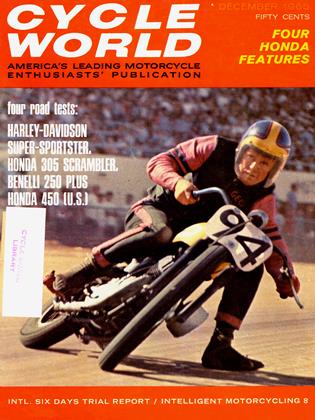HONDA TRAIL 90
Cycle World Trial Test
WORLD'S BIGGEST SELLER, is the claim of Honda; we cannot deny they sell an awful lot of motorcycles. Large and small, the word Honda is almost generic in this day of motorcycles, appearing on the pages of all of the national magazines (and even in fashion advertisements in Vogue). If the upper end of the Honda line is the new 450, the center, and perhaps the most important segment of their range, is the Honda Trail 90. The Trail 55 may be more popular, based on price, but the 90 is the perfect answer for the novice trail riding enthusiast, particularly if he has had little or no previous experience on a motorcycle. Most people that fit this description who might be interested in motorcycles are, of course, the motorized hunters or fishermen. It is for them that the Trail 90 was designed.
As a comparison to the Trail 55 (the 55cc version), the 90 offers 30% more power, for not quite that much more money. Among the other small improvements over the old Trail 55, but not the latest of course, is the U.S. Department of Forestry approved spark arrester/muffler. It is fast becoming a most necessary accessory, if one wants to be able to enjoy what remains of the wilderness he is still allowed to travel in. Honda's Forestry Service-approved spark arrester is standard equipment on trail models, saving a bit of trouble for the serious trail rider and offering a small advantage over some of the competing trail bikes.
We even took the Trail 90 to the Bonneville salt flats with us, not to see how fast it would go (that is not very fast), but to use as our transportation between photographic vantage points.
To return to the biggest selling point of the Honda Trail 90, we need only pass over the automatic clutch, and the handlebar mounting of both brake levers, front and rear! We were continually confused by the lever on the left hand side that operated the rear brake. To the man, each staff member who rode it almost got in trouble by locking up the rear wheel during a "gear change." Obvious reason, to us anyway, for the feature, can be seen by watching all of the first, or second, time dirt or trail riders, when the going gets steep. 'We haven't seen one yet, going up, or coming down, who could keep his feet on the perches provided for them. One can easily picture the difficulties of trying to brake when both feet are dragging on the ground. Hence the two-wheel hand brakes.
Honda rates the Trail 90, or CT-200 to use the proper nomenclature, with 6.0 hp @ 7,500 rpm. Valves, pushrods, camshafts and several other things are rattling like crazy at this engine speed. We have found, in the long run, that worrying about the noises is generally a waste of time as the little engine will do it almost endlessly.
Readers might deduce from the foregoing that the 90 is not a machine for the experienced rider. In several areas of consideration, this is quite true. Ah, but, it handles very well, has more than ample power, and is great fun to ride. Our only profound criticism is in the front suspension; not enough up and down travel is provided in the leading link suspension, the only throwback to Honda's "old days." Ground clearance is all that can be expected. Gearing is fine, and gear ratios are well chosen. Should the rider desire a spin on the pavement, a few minutes changing the rear chain from one sprocket to another (two are provided, side by side), and he has a bike that will run along at a plus-50-mph cruising speed.
Full lighting 4s standard, as are full steel fenders, more than adequate air cleaner, engine protective guard, luggage rack, high-mounted exhaust pipe, proper handlebars, two-speed sprockets as previously covered, folding footpegs, and anything else one might think of. In short; the accessory makers hate this model Honda. We will give them their due, elsewhere in this issue, with the tale of a Honda 160, dressed to the teeth with something other than Honda's equipment.
An automatic clutch is standard, eliminating the "chore" of using the clutch in both starting from standing still, and changing gears under way; yet another facet of appeal to the non-motorcycling trail rider or hunter/fisherman who clamps it on to the back of his camper and heads for the hills. We aren't trying to out-guess Honda, or anyone else for that matter, but they certainly know their market. Closing line of the sales brochure reads: "no extras needed," we don't need any either to end this test.
 View Full Issue
View Full Issue








